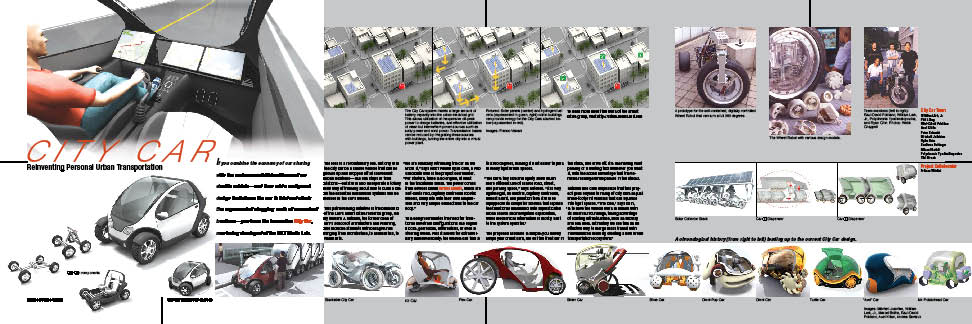If you own a car and live or work in a major city, you've had the experience of circling the block and driving street after street trying to find a place to park. Maybe you've even shouted in triumph after spotting an open space - Yes! - only to discover that your car didn't quite fit. You kept on looking. How much time and gas did you waste before your "parking angel" finally came through?
William Mitchell has wondered as well. As director of the Design Laboratory at MIT's Media Lab, Mitchell is part of a research team that is rethinking the nature of urban personal transportation. In a guest presentation on September 28th at the MIT Center for Real Estate's annual Graduation Weekend, Mitchell gave a talk about his team's City Car, a revolutionary concept vehicle that seeks to dramatically raise urban transportation's efficiency and lower its environmental impact.
Electric, lightweight, simple, quick, efficient, and nearly silent, the City Car would also be much less expensive (about 80% less) than an average auto. It would have the tiny "footprint" of the newly fashionable Smart Car. Unlike the Smart Car, however, the City Car could literally fold in half - to get the visuals, think inchworm - on hinges built midway along its frame, shrinking its footprint another 50%.
Folded cars could then be stacked into each other like shopping carts, drastically reducing the vehicle footprint for parking, and eliminating residual space between cars. Mitchell gave an example of that increased efficiency in Manhattan's Upper West Side. "A city block currently accommodates about 80 vehicles," he said. "With the City Car, that number could be increased to 500."
The car would eliminate the need for traditional drive train components like engine blocks, gear boxes, and differentials by using four electric "wheel robots" - modular components that include digitally controlled electric motors and suspension systems. These self-contained units would allow the wheels 360 degrees of movement, allowing, for example, sideways parking. How powerful would the motors be? "We'd conceivably be able to make them as fast as a Formula 1 car, but for obvious reasons, we wouldn't," Mitchell said.
As important as the design of the car itself is the design of the urban infrastructure supporting it. Mitchell, who has a background in design, but also in architecture and urban planning, sees the City Car parked at key points throughout a city - subway lines, bus stops, even traditional parking lots - augmenting the existing transportation infrastructure.
To get a car from a stack - which would serve to store the vehicles and to recharge them - users would simply swipe their credit cards, take the first car in the stack (as with an airport luggage cart), then drive to their destination and leave the car in another stack. Located at key points of convergence, vehicle stacks would let users efficiently combine mass transit with individualized mobility.
The efficiency of such a scheme would contrast markedly with that of current auto use; using a Zip Car-type of shared-use model, City Cars could be in motion upwards of 80% of the time, whereas traditional autos are in motion only 20% of the time.
Asked whether the City Car would have the comforts modern drivers have come to expect, Mitchell said, "These are not golf carts. You'd have all the comforts and features you've come to expect from our cars, plus more."
More means smarts. As a "car of the future," the City Car would be both intelligent and adaptive. Drive-by-wire functionality would take advantage of wireless connectivity and a Google-like information grid to let operators efficiently choose from the city's array of cultural and commercial resources, then navigate there in the most intelligent way. Users could give the car broad instructions, and rely on its intelligent use of information technology to predict and answer questions even before they are asked.
"The wirelessly enabled cars could know in advance parking space availability in other locations," Mitchell said, "and let users intelligently play the 'space market' by specifying, for example, the cheapest route, the fastest route, or any number of alternatives." In addition, credit cards could store user preferences and settings to accommodate different driving styles and configurations.
The car's design would be fully modular, using snap-together construction; parts could be assembled in small shop-sized facilities rather than on sprawling, centralized assembly lines. Mitchell describes how he and his team stored the prototype's modular components in luggage and carry-on bags, then flew to General Motors to assemble the car in the GM boardroom to demonstrate it to executives. "Of course, we had some rather interesting conversations with security personnel at Logan Airport," he said.
The City Car wouldn't necessarily replace personal vehicles, taxis, buses, or trucks (though theoretically, it could; a motor scooter that pivots and folds - a la Transformers - is in development). Instead, the car would introduce a new type of more efficient and sustainable vehicle to current urban transportation systems, adding an intelligent element to transportation choices.
Mitchell acknowledges that an emissionless car depending on electricity from the current grid would "hand off" much of its carbon footprint to an electricity generating plant somewhere else, posing other environmental challenges. But research has shown that even with today's technologies, electric cars hooked into the grid have significantly less environmental impact than average gasoline powered autos, and that advantage will improve even more with research.
To find out more about the MIT Media Lab's City car, visit http://cities.media.mit.edu/
Micheal Mack is an affiliate writer for MIT Center for Real Estate Cambridge, Mass.
Tags:
Transportation becomes architectural in MIT's City Car; rethinking the nature of urban transportation
November 19, 2007 - Front Section









